The ASUS TUF X99 Sabertooth Review
by Ian Cutress on July 22, 2015 10:00 AM EST- Posted in
- Motherboards
- Asus
- TUF
- X99
Gaming Performance 2015
Alien: Isolation
If first person survival mixed with horror is your sort of thing, then Alien: Isolation, based off of the Alien franchise, should be an interesting title. Developed by The Creative Assembly and released in October 2014, Alien: Isolation has won numerous awards from Game Of The Year to several top 10s/25s and Best Horror titles, ratcheting up over a million sales by February 2015. Alien: Isolation uses a custom built engine which includes dynamic sound effects and should be fully multi-core enabled.
For low end graphics, we test at 720p with Ultra settings, whereas for mid and high range graphics we bump this up to 1080p, taking the average frame rate as our marker with a scripted version of the built-in benchmark.

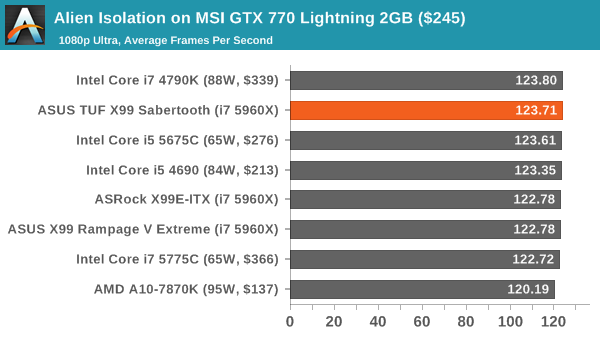
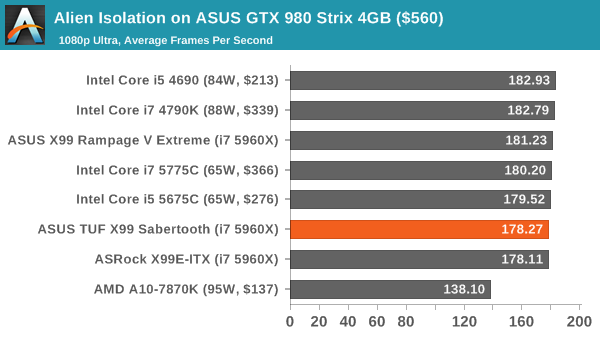
Total War: Attila
The Total War franchise moves on to Attila, another The Creative Assembly development, and is a stand-alone strategy title set in 395AD where the main story line lets the gamer take control of the leader of the Huns in order to conquer parts of the world. Graphically the game can render hundreds/thousands of units on screen at once, all with their individual actions and can put some of the big cards to task.
For low end graphics, we test at 720p with performance settings, recording the average frame rate. With mid and high range graphics, we test at 1080p with the quality setting. In both circumstances, unlimited video memory is enabled and the in-game scripted benchmark is used.
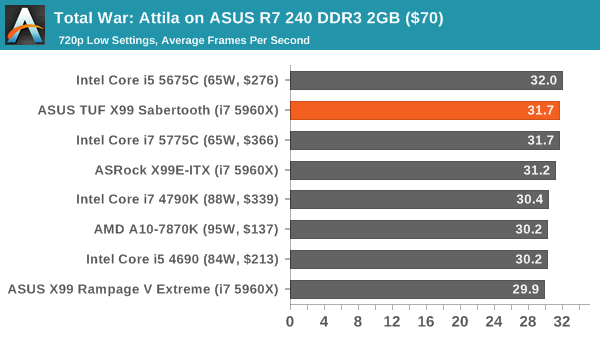
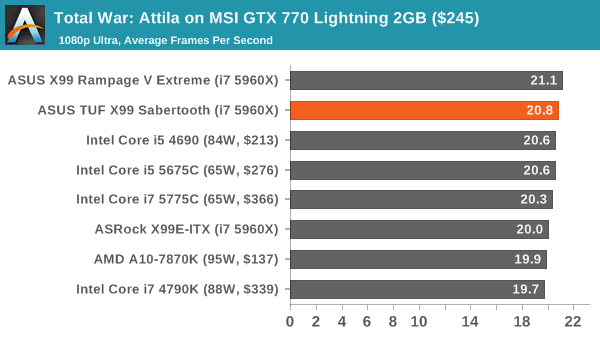
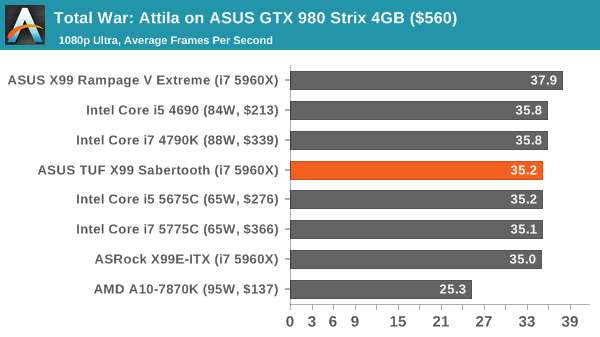
Grand Theft Auto V
The highly anticipated iteration of the Grand Theft Auto franchise finally hit the shelves on April 14th 2015, with both AMD and NVIDIA in tow to help optimize the title. GTA doesn’t provide graphical presets, but opens up the options to users and extends the boundaries by pushing even the hardest systems to the limit using Rockstar’s Advanced Game Engine. Whether the user is flying high in the mountains with long draw distances or dealing with assorted trash in the city, when cranked up to maximum it creates stunning visuals but hard work for both the CPU and the GPU.
For our test we have scripted a version of the in-game benchmark, relying only on the final part which combines a flight scene along with an in-city drive-by followed by a tanker explosion. For low end systems we test at 720p on the lowest settings, whereas mid and high end graphics play at 1080p with very high settings across the board. We record both the average frame rate and the percentage of frames under 60 FPS (16.6ms).

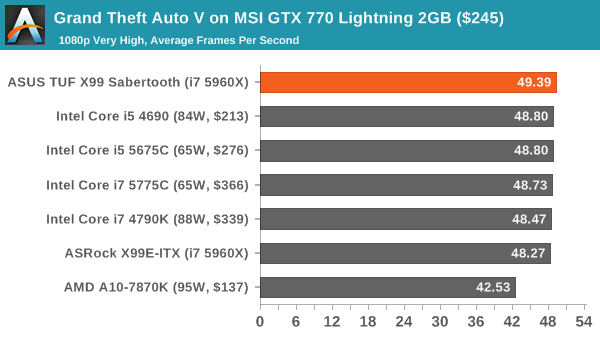
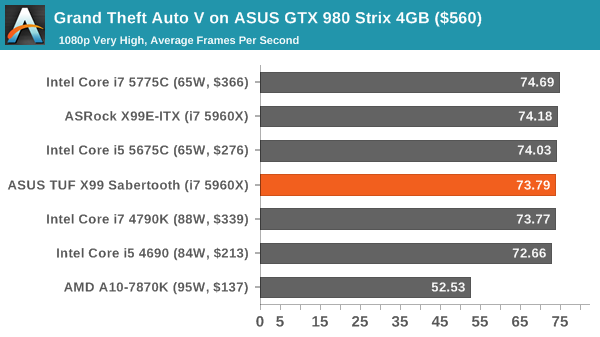
GRID: Autosport
No graphics tests are complete without some input from Codemasters and the EGO engine, which means for this round of testing we point towards GRID: Autosport, the next iteration in the GRID and racing genre. As with our previous racing testing, each update to the engine aims to add in effects, reflections, detail and realism, with Codemasters making ‘authenticity’ a main focal point for this version.
GRID’s benchmark mode is very flexible, and as a result we created a test race using a shortened version of the Red Bull Ring with twelve cars doing two laps. The car is focus starts last and is quite fast, but usually finishes second or third. For low end graphics we test at 1080p medium settings, whereas mid and high end graphics get the full 1080p maximum. Both the average and minimum frame rates are recorded.
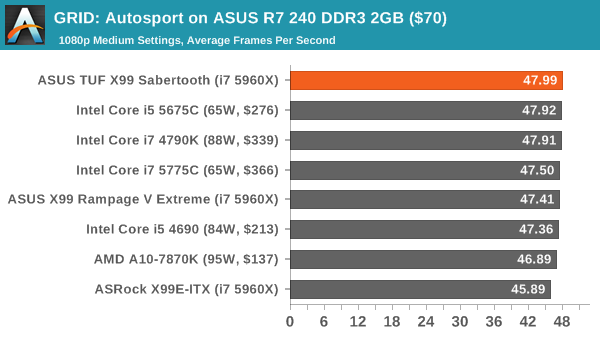
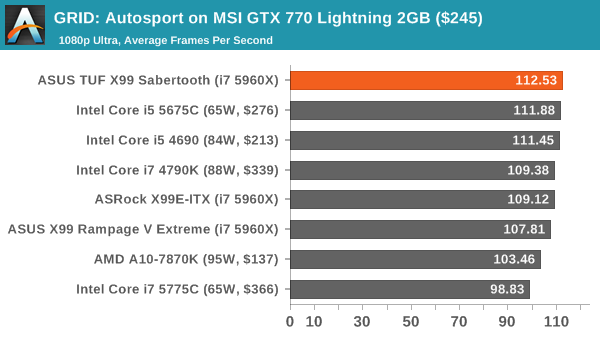
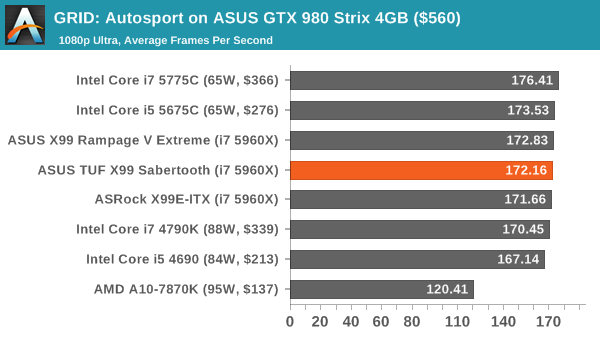
Middle-Earth: Shadows of Mordor
The final title in our testing is another battle of system performance with the open world action-adventure title, Shadows of Mordor. Produced by Monolith using the LithTech Jupiter EX engine and numerous detail add-ons, SoM goes for detail and complexity to a large extent, despite having to be cut down from the original plans. The main story itself was written by the same writer as Red Dead Redemption, and it received Zero Punctuation’s Game of The Year in 2014.
For testing purposes, SoM gives a dynamic screen resolution setting, allowing us to render at high resolutions that are then scaled down to the monitor. As a result, we get several tests using the in-game benchmark. For low end graphics we examine at 720p with low settings, whereas mid and high end graphics get 1080p Ultra. The top graphics test is also redone at 3840x2160, also with Ultra settings, and we also test two cards at 4K where possible.
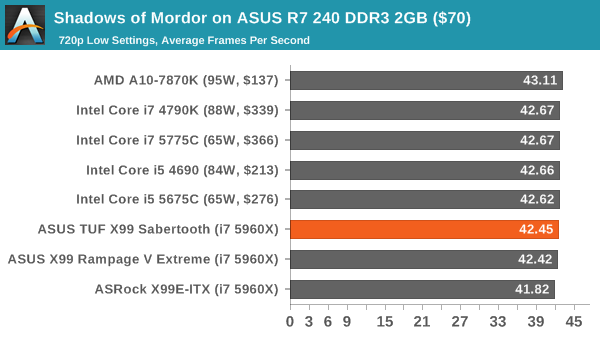
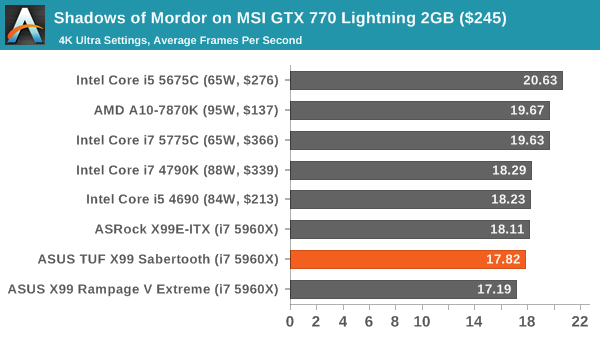

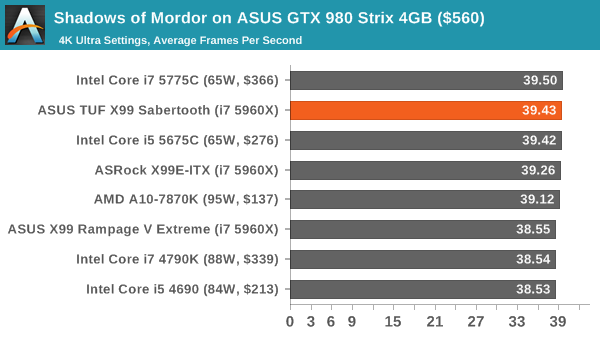
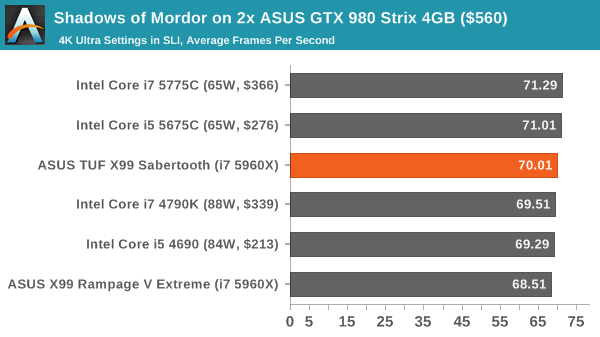















57 Comments
View All Comments
Shadowmaster625 - Wednesday, July 22, 2015 - link
lol it even has dust caps for the microphone port.Stuka87 - Wednesday, July 22, 2015 - link
Really a nice looking board. I like the PCI-E covers one slots you may not be using.Out of curiosity, why are you guys still testing with Windows 7 rather than 8.1? Will you guys be moving to Windows 10 soon?
AndrewJacksonZA - Wednesday, July 22, 2015 - link
As soon as it's commercially available and all benchmark software has been tested to make sure that they still work I hope. :-)Souka - Thursday, July 23, 2015 - link
What about Windows 8.1?abrowne1993 - Wednesday, July 22, 2015 - link
"It didn’t detect the DDR3 on the graphics card correctly though!"GDDR5?
Ryan Smith - Wednesday, July 22, 2015 - link
The R7 240 is a DDR3 card.Achaios - Wednesday, July 22, 2015 - link
@Staff: There is a rather huge issue with ASUS X99 motherboards destroying CPU's (5960X's, 5820k's, etc). Google "5960X Dead overclock.net".To my understanding, there is a chance that the ASUS X99 motherboard will raise on its own the CPU Vcore of the CPU to around 1.85V which, as we have learned, kills CPUs in a matter of seconds.
The latest incident reported was 4.5 hours ago. ASUS has refused to comment or acknowledge the issue. So, in view of the above, I would not buy an ASUS X99.
Achaios - Wednesday, July 22, 2015 - link
Correction: Latest incident reported 2 days and 8 hours ago on a "RVE", i.e. Rampage V Extreme X99. According to the person writing the report, he did try to RMA the board butQUOTE "ASUS were just dismissive and very unfriendly and said no".
Treating enthusiasts like dogs really angers me.
Gothmoth - Wednesday, July 22, 2015 - link
lol.... "enthusiast" who probably killed their system because they have no clue how to overclock.now they claim it´s a board problem. of course all x99 asus boards are affected.
i have SIX asus X99 boards and they run flawless for years.
an where is the source for the "incident" you reported?
without giving a source this is even more likr UFO sightings.....
Achaios - Wednesday, July 22, 2015 - link
http://www.overclock.net/t/1561131/5960x-dead